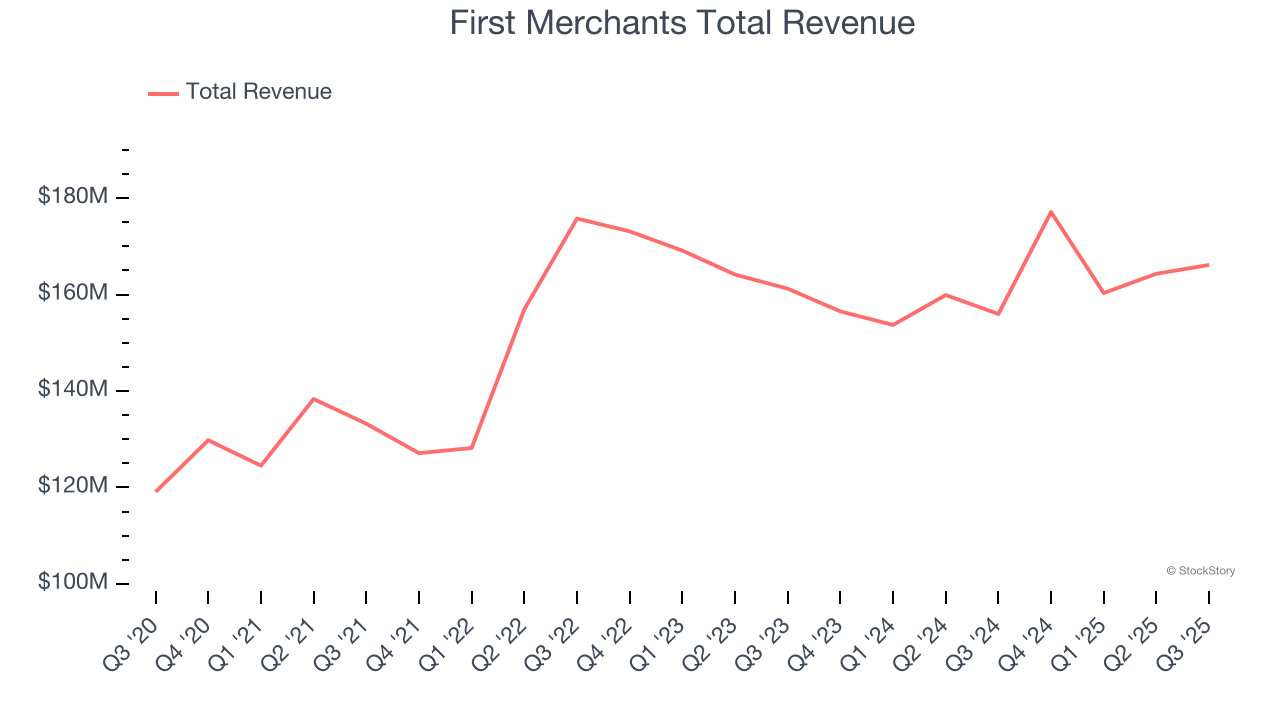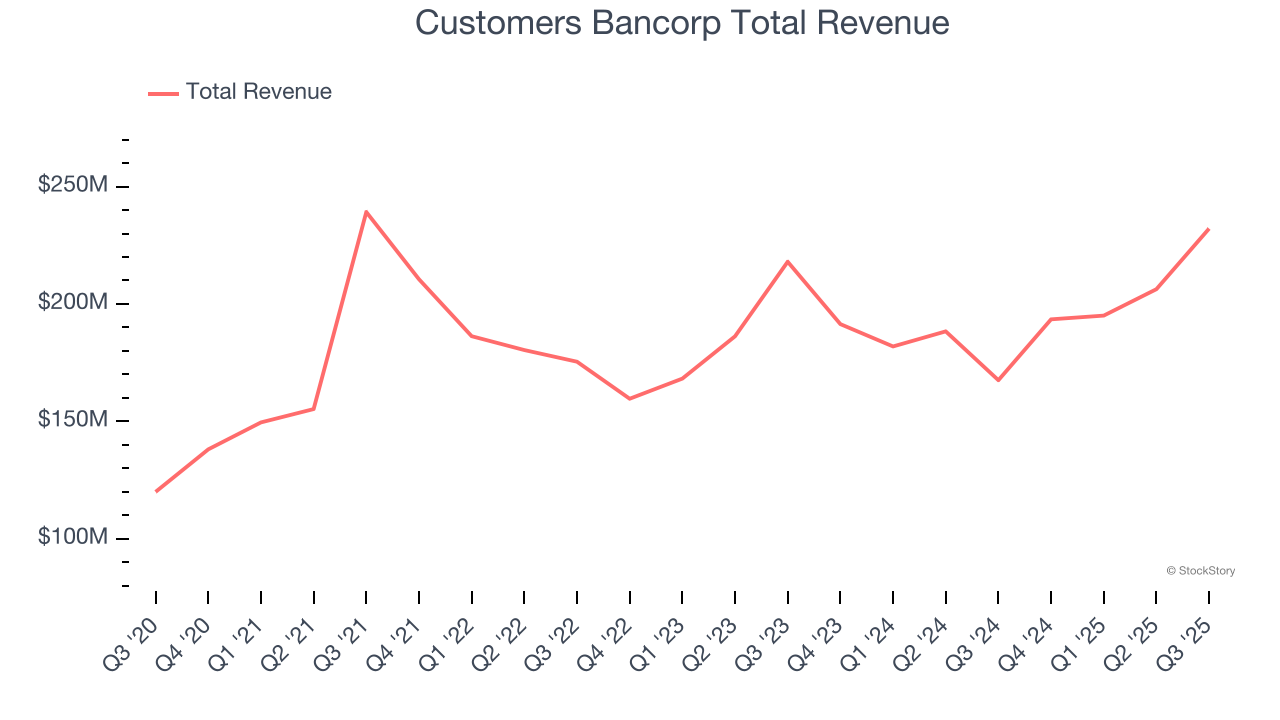
As the Q3 earnings season comes to a close, it’s time to take stock of this quarter’s best and worst performers in the regional banks industry, including First Merchants (NASDAQ:FRME) and its peers.
Regional banks, financial institutions operating within specific geographic areas, serve as intermediaries between local depositors and borrowers. They benefit from rising interest rates that improve net interest margins (the difference between loan yields and deposit costs), digital transformation reducing operational expenses, and local economic growth driving loan demand. However, these banks face headwinds from fintech competition, deposit outflows to higher-yielding alternatives, credit deterioration (increasing loan defaults) during economic slowdowns, and regulatory compliance costs. Recent concerns about regional bank stability following high-profile failures and significant commercial real estate exposure present additional challenges.
The 94 regional banks stocks we track reported a satisfactory Q3. As a group, revenues missed analysts’ consensus estimates by 1.1%.
While some regional banks stocks have fared somewhat better than others, they have collectively declined. On average, share prices are down 1.7% since the latest earnings results.
First Merchants (NASDAQ:FRME)
Dating back to 1893 when it first opened its doors in Indiana, First Merchants (NASDAQ:FRME) is a Midwest regional bank providing commercial, consumer, and wealth management services through branches in Indiana, Ohio, Michigan, and Illinois.
First Merchants reported revenues of $166.1 million, up 6.5% year on year. This print was in line with analysts’ expectations, but overall, it was a slower quarter for the company with a significant miss of analysts’ net interest income estimates and a narrow beat of analysts’ EPS estimates.
"Our strong year-to-date balance sheet and earnings performance underscore the strength and resilience of our business model. Our return on assets, return on tangible capital, and efficiency ratio are in the top-quartile relative to our peers, reflecting disciplined execution and operational excellence," said Mark Hardwick, Chief Executive Officer.

Unsurprisingly, the stock is down 3.5% since reporting and currently trades at $35.34.
Read our full report on First Merchants here, it’s free for active Edge members.
Best Q3: Customers Bancorp (NYSE:CUBI)
Originally founded with a "high-tech, high-touch" branch-light banking strategy, Customers Bancorp (NYSE:CUBI) is a bank holding company that provides commercial and consumer banking services through its Customers Bank subsidiary, with a focus on business lending and digital banking.
Customers Bancorp reported revenues of $232.1 million, up 38.5% year on year, outperforming analysts’ expectations by 7%. The business had a stunning quarter with a solid beat of analysts’ net interest income estimates and an impressive beat of analysts’ revenue estimates.

However, the results were likely priced into the stock as it’s traded sideways since reporting. Shares currently sit at $65.
Is now the time to buy Customers Bancorp? Access our full analysis of the earnings results here, it’s free for active Edge members.
Weakest Q3: The Bancorp (NASDAQ:TBBK)
Operating behind the scenes of many popular fintech apps and prepaid cards you might use daily, The Bancorp (NASDAQ:TBBK) is a bank holding company that specializes in providing banking services to fintech companies and offering specialty lending products.
The Bancorp reported revenues of $174.6 million, up 38.8% year on year, falling short of analysts’ expectations by 10%. It was a disappointing quarter as it posted a significant miss of analysts’ revenue and net interest income estimates.
As expected, the stock is down 23% since the results and currently trades at $59.45.
Read our full analysis of The Bancorp’s results here.
National Bank Holdings (NYSE:NBHC)
Operating under familiar local brands like Community Banks of Colorado, Bank Midwest, and Bank of Jackson Hole, National Bank Holdings (NYSE:NBHC) operates regional banks across Colorado, Kansas, Missouri, Wyoming, Texas, and other western states, offering commercial, business, and consumer banking services.
National Bank Holdings reported revenues of $108.9 million, up 2.7% year on year. This print beat analysts’ expectations by 3.9%. Aside from that, it was a mixed quarter as it also produced an impressive beat of analysts’ revenue estimates but a significant miss of analysts’ net interest income estimates.
The stock is down 3.5% since reporting and currently trades at $35.73.
Read our full, actionable report on National Bank Holdings here, it’s free for active Edge members.
Amalgamated Financial (NASDAQ:AMAL)
Founded in 1923 by labor unions seeking a financial institution aligned with worker values, Amalgamated Financial (NASDAQGM:AMAL) operates a values-oriented bank that provides commercial banking, trust services, and investment management to socially responsible organizations and individuals.
Amalgamated Financial reported revenues of $86.41 million, up 6.6% year on year. This number surpassed analysts’ expectations by 3.7%. It was a strong quarter as it also produced a solid beat of analysts’ revenue estimates and an impressive beat of analysts’ net interest income estimates.
The stock is up 3.8% since reporting and currently trades at $27.70.
Read our full, actionable report on Amalgamated Financial here, it’s free for active Edge members.
Market Update
Thanks to the Fed’s series of rate hikes in 2022 and 2023, inflation has cooled significantly from its post-pandemic highs, drawing closer to the 2% goal. This disinflation has occurred without severely impacting economic growth, suggesting the success of a soft landing. The stock market thrived in 2024, spurred by recent rate cuts (0.5% in September and 0.25% in November), and a notable surge followed Donald Trump’s presidential election win in November, propelling indices to historic highs. Nonetheless, the outlook for 2025 remains clouded by potential trade policy changes and corporate tax discussions, which could impact business confidence and growth. The path forward holds both optimism and caution as new policies take shape.
Want to invest in winners with rock-solid fundamentals? Check out our Top 5 Quality Compounder Stocks and add them to your watchlist. These companies are poised for growth regardless of the political or macroeconomic climate.
StockStory’s analyst team — all seasoned professional investors — uses quantitative analysis and automation to deliver market-beating insights faster and with higher quality.
